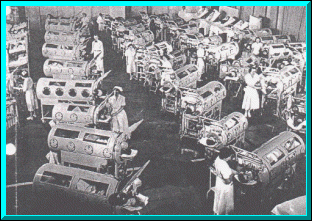My name is virus poliomyelitis.
I cause a disease which you call infantile paralysis.
I consider myself quite an artist -- sort of a sculptor.
I specialize in the grotesques, twisting and deforming human bodies.
That's why I'm called "The Crippler." 1
Page 1 | Page 2 | Page 3
People didn't know how polio was spread, but they did know that most
diseases were spread from person to person. When polio came to town, isolation was
the name of the game. Events were cancelled, children were confined to their homes.
During the hottest days of summer, pools were closed. Schools and camps were
shut down. Movie theatres were closed on order of the health authorities.
Drinking fountains were abandoned. Draft inductions were suspended.
That worked for influenza and plague and a host of other diseases, but polio did not
respond.2
In 1930, a Connecticut outbreak caused Wesleyan University to cancel its
football season. Almost 150 students dropped out of school. Schools in Topeka,
Kansas, were closed. Public meetings were banned in Los Angeles.
In 1931, there was another epidemic in New York.
In 1932, there were epidemics in New Jersey, Pennsylvania, and Los
Angeles. Los Angeles' epidemic was so bad that the city's public health services
began to break down. Ambulances and stretchers blocked the streets in front of the
county hospital, where frightened hospital workers turned people away.

Los Angeles County Hospital polio ward c. 1950.
Photo courtesy Virtual Museum of the
Iron Lung
In 1935, Boston got an epidemic. The entire city of Annapolis,
Maryland was quarantined. The National Boy Scout Jamboree in Virginia was cancelled.
In 1936, Tulsa, Oklahoma was quarantined. Chicago suffered a large
epidemic, too. Alabama churches and resorts were closed.
In 1939, some victims of bulbar polio had survived for ten years in iron
lungs. That same year, a woman gave birth in an iron lung.3
And now I see with eye serene
The very pulse of the machine;
A being breathing thoughtful breath;
A traveler betwixt life and death.
-William Wordsworth
It must have been profoundly difficult in that first quarter-century of
polio. How helpless parents must have felt to know that there was this killer that
could come each summer, and that nothing they could do could safeguard their
children. Every sniffle, every cold, every muscle cramp, every temper tantrum that a
child exhibited in the long, hot days of summer and early autumn were potential symptoms
of polio. How long could a family show good spirits in front of a child confined to
an iron lung, or later, during the two or more years a child might spend in rehabilitative
therapy.
Polio was never the worst disease in the nation. Many other
contemporary diseases killed more. But polio seemed to go after the innocent
children, and it left such pathetic reminders of its passage. It was an affront to
American technological and medical prowess and a denial of our new affluence and national
strength. It had to be conquered, and the sooner the better.
Page 1 | Page 2 | Page 3


Footnotes
1. Seavey, Nina Gilden (writer and director). "A
Paralyzing Fear: The Story of Polio in America." Oregon Public
Broadcasting. 1998.
2. Smith, Jane S. Patenting the Sun: Polio and the
Salk Vaccine. New York, New York: William Morrow and Company, Inc.
1990. p. 35.
3. idem. p. 39. |
